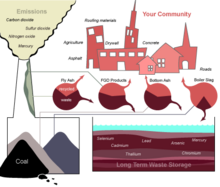Term: Coal combustion products
**Coal Combustion Products:**
– Fly Ash:
– Comprises 60% of coal combustion waste
– Used as substitute for Portland cement
– Common in building materials like grouts and roofing tiles
– Found in asphaltic concrete pavements
– Utilized in geotechnical applications like soil stabilization
– Flue-Gas Desulfurization (FGD) Materials:
– Produced by chemical scrubber emission control systems
– Comprise 24% of coal combustion waste
– Common types include FGD gypsum and spray dryer absorbents
– Used in gypsum panel products and agricultural applications
– Applied in mining and land reclamation activities
– Bottom Ash and Boiler Slag:
– Used as raw feed for manufacturing Portland cement clinker
– Comprise 12% and 4% of coal combustion waste respectively
– Suitable for geotechnical applications like structural fills
– Used in concrete masonry products
– Boiler slag also used for roofing granules and blasting grit
**Fly Ash Composition and Characteristics:**
– Contains silicon dioxide, aluminum oxide, and calcium oxide
– Can include trace elements like arsenic, lead, and mercury
– Used as lightweight aggregate with economic and environmental benefits
– Stored at coal power plants or in landfills
– Classified into Class F and Class C fly ash by ASTM
– Solidifies in exhaust gases and collected by filters
– Spherical particles ranging from 0.5 µm to 300 µm
– Contains SiO2, Al2O3, Fe2O3, and CaO
– Diverse mineralogy including glass phase, quartz, and iron oxides
– Mercury content can reach 1 ppm, varies based on coal type
**Types and Benefits of Fly Ash:**
– Types of Fly Ash:
– Class F: from burning older anthracite and bituminous coals
– Class C: from burning younger lignite or sub-bituminous coal
– Class C fly ash hardens and strengthens with water
– Class C contains over 20% lime (CaO)
– Class C does not need an activator
– Benefits of Fly Ash Bricks:
– Bricks meet ASTM standards
– Estimated 90% reduction in masonry construction energy
– Commercial availability expected by end of 2009
– Fly ash brick can contain up to 50% Class C fly ash
– Bricks meet shrinkage limits for concrete brick
**Disposal and Environmental Impact:**
– Disposal and Market Sources:
– Over 65% of fly ash is disposed in landfills and ash ponds
– Environmental concerns led to laws reducing fly ash emissions
– Stored ash can leach toxins into water aquifers
– Debate focuses on creating lined landfills for safe disposal
– Coal plants often located near metropolitan areas and water sources
– Environmental Impact:
– Fly ash previously dispersed into the atmosphere
– Laws in industrialized countries reduced fly ash emissions
– Unlined fly ash basins pose risks of spills and flooding
– Fly ash stored outdoors can leach toxic compounds
– Current focus on preventing chemical leaching into groundwater
**Future Trends and Innovations:**
– Fly ash used in geopolymer production
– Expected increase in fly ash brick production
– Growing interest in sustainable construction materials
– Research on enhancing fly ash properties for construction
– Regulations driving innovation in fly ash disposal technologies
Coal combustion products (CCPs), also called coal combustion wastes (CCWs) or coal combustion residuals (CCRs), are categorized in four groups, each based on physical and chemical forms derived from coal combustion methods and emission controls:

- Fly ash is captured after coal combustion by filters (bag houses), electrostatic precipitators and other air pollution control devices. It comprises 60 percent of all coal combustion waste (labeled here as coal combustion products). It is most commonly used as a high-performance substitute for Portland cement or as clinker for Portland cement production. Cements blended with fly ash are becoming more common. Building material applications range from grouts and masonry products to cellular concrete and roofing tiles. Many asphaltic concrete pavements contain fly ash. Geotechnical applications include soil stabilization, road base, structural fill, embankments and mine reclamation. Fly ash also serves as filler in wood and plastic products, paints and metal castings.
- Flue-gas desulfurization (FGD) materials are produced by chemical "scrubber" emission control systems that remove sulfur and oxides from power plant flue gas streams. FGD comprises 24 percent of all coal combustion waste. Residues vary, but the most common are FGD gypsum (or "synthetic" gypsum) and spray dryer absorbents. FGD gypsum is used in almost thirty percent of the gypsum panel products manufactured in the U.S. It is also used in agricultural applications to treat undesirable soil conditions and to improve crop performance. Other FGD materials are used in mining and land reclamation activities.
- Bottom ash and boiler slag can be used as a raw feed for manufacturing portland cement clinker, as well as for skid control on icy roads. The two materials comprise 12 and 4 percent of coal combustion waste respectively. These materials are also suitable for geotechnical applications such as structural fills and land reclamation. The physical characteristics of bottom ash and boiler slag lend themselves as replacements for aggregate in flowable fill and in concrete masonry products. Boiler slag is also used for roofing granules and as blasting grit.
